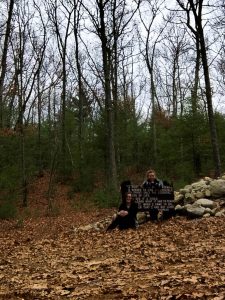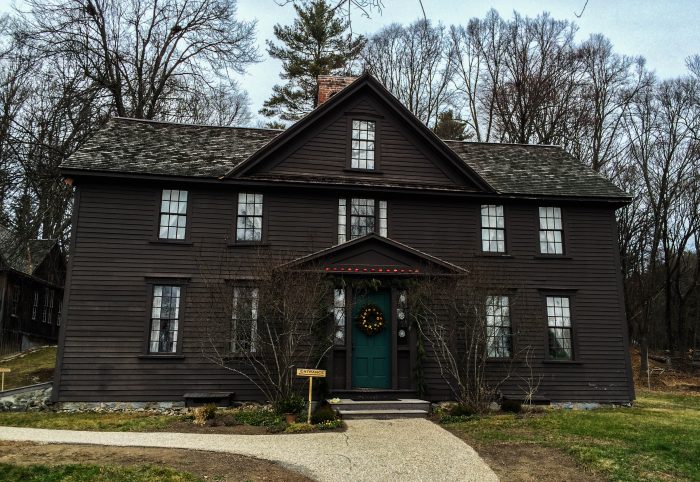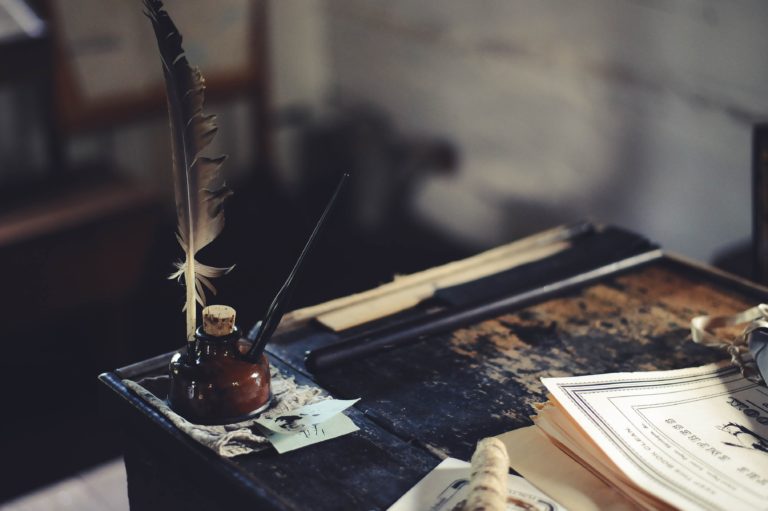A lake is a landscape’s most beautiful and expressive feature. It is Earth’s eye; looking into which the beholder measures the depth of his own nature. — Henry David Thoreau
On our second day in Concord, we managed to wake up early despite attending a wedding the night before. We made time to see Old Manse and visit Sleepy Hollow Cemetery. Now, we wanted to explore just outside of town to a pond made famous by the Transcendentalist writer who lived next to it for a few years in the mid-19th century.
What better way to start the morning than breakfast at Walden Pond?

The day was cloudy, but delightfully cool and pleasant for the first week in December. We took our coffee and pastries with us as we walked down to Walden Pond, its beaches sparsely populated with tourists. Neither of us spoke as we admired the view and let the coffee warm and and wake us up.

We walked along the dirt path that circled the pond, which is also known as a kettle hole, formed by retreating glaciers some ten thousand years ago. It was a fairly innocuous pond until a poet and, I suppose, philosopher, decided to live in a small cabin near it for a few years to “live deliberately.” I could see why, because it was a beautiful spot; a haven not that far from Concord’s outskirts.
I read portions of Henry David Thoreau’s Walden in college, and truthfully found him to be a self important man who just so happened to write beautifully. His descriptions of Walden Pond and the surrounding area do it justice, but I could never get behind some of his viewpoints, with the exception of his abolitionism and naturalism. Visiting Walden Pond, then, became more of an homage to a canon piece of American literature, and to confirm for myself how Thoreau might have really lived out there.

Walden Pond and the site of Thoreau’s cabin has become something more, and something lovelier, than during Thoreau’s time there. Visitors have created a piece of ever-evolving art out of the old cabin’s site, which no longer stands there but the foundation does. The important thing to remember, when you leave the pond behind and walk further into the woods, is to bring a rock with you. A rock, and a quote in your heart that you wish to leave on its surface for other people to find.

When we reached Thoreau’s cabin site, we found a large pile of rocks, many of which contained those quotes on their roughened surfaces. We sat down and took our time reading each one; the morning was so quiet, empty, and still, that we were not disturbed as we explored. We wished we had known so we could contribute to the pile, but at the same time, it was wonderful to stumble upon this without knowing ahead of time.
Thoreau spent a little over two years in that spot, from 1845 to 1847, living alone in a tiny house he built for himself. He lived, for a time, in a secluded atmosphere enviable to any writer who wishes to sequester themselves from society in order to create.
She is too fond of books, and it has turned her brain. — Louisa May Alcott
After our morning reflection at Walden Pond, we went back into Concord and visited the gift shops, antique stores, and bookstores. Once it came time for our tour, we drove down to a brown house where Louisa May Alcott, our girl Jo, lived and wrote Little Women.

Orchard House is named after the apple orchard on the grounds the Alcotts owned; Amos Bronson Alcott, Louisa’s father, was particularly fond of apples. The family of six moved into the house in 1857, after living like nomads and moving around an impressive twenty-two times in almost thirty years. Amos was a teacher and a philosopher, and homeschooled all four of his girls. He also had a difficult time holding down a job because his teaching methods—far ahead of his time—were so controversial (no traditional punishment? Talking to students like people? L’horreur!). The Alcotts, in turn, didn’t have a lot of money, and so the family moved often to find the next opportunity.
Amos was an Abolitionist and advocate for women’s rights, a friend of Ralph Waldo Emerson’s, and a fellow Transcendentalist. He and Abby May, an activist and one of the first paid social workers in Massachusetts, married in 1830, and their four daughters flourished artistically with parents who encouraged them to pursue their passions. Louisa May, our most famous Alcott daughter, gave us Little Women in 1868 (one of the most widely read novels out there, not too shabby), and I never quite realized how much of Little Women was drawn directly from Louisa’s life until I was in her house.
The family members themselves escorted us through a guided tour of their home, graciously allowing us to wander and inspect the furniture, knick-knacks, and pictures, the majority of which were actually owned by the Walcotts. The entry walls at the beginning of the tour are filled with May Alcott’s ink portraits of the family. May (Amy March) was the youngest Alcott and quite the artist. Her fingerprints are visible all over the house, but especially in her room upstairs, where more of her portraits and murals cover the walls, surprisingly vibrant despite their age.
The dining room still holds the Alcott’s fine china, and the room itself also served as the stage where the girls would put on their plays for family and friends. Elizabeth (sweet Beth March), a musician, had a small reed organ in the dining room. She didn’t live in the house long, however; Lizzie died at twenty-two after contracting scarlet fever.
We passed the parlor where Anna, the oldest daughter (and Meg March), married John Pratt in 1860, as Meg marries John Brooke in the novel. Room by room, we were transported deeper into Orchard House as it had been when the Alcotts lived there and Louisa (Jo) used it and her time there as inspiration for Little Women. Louisa certainly didn’t lack for literary influences outside of her enlightened parents; Orchard House received friendly neighborhood visits from the likes of Ralph Waldo Emerson and Nathaniel Hawthorne. Amos’s dreams of opening a school again came true, as well, because through a generous benefactor, he was able to construct a building on his property for the Concord School of Philosophy in 1879, an adult summer school based on Plato’s Academy. 
Emerson, Julia Ward Howe (ever heard the Battle Hymn of the Republic? She wrote that) and Elizabeth Peabody (opened the nation’s first kindergarten) gave lectures at the school, which drew hundreds of participants each year (over half women). The school only had an eight year run and shut down when Amos passed away in 1888, but it made a lasting impression during the Transcendentalist movement, and remains in use today to promote intellectual stimulation, progressive thought, and support of the arts.
When the tour came to an end, we stopped in one of the rooms downstairs to become part of a holiday play with the Alcott sisters. We were given sleigh bells attached to old leather straps, and sang Jingle Bells in a home that had no doubt heard many songs and laughter through the years. I left feeling closer to Jo, Beth, Meg, and Amy, and I could not wait to reread Little Women after spending time in the rooms where Louisa breathed life into the sisters. Not a difficult task, since her inspiration for them lived in those rooms and in her own heart. Our love for the March sisters is really our love for the Alcott sisters.
I left Orchard House with a hooded cape and a renewed appreciation for what this small, beautiful corner of the world gave us. Our trip was short, but time had slowed to a crawl as we walked through Concord with barely an eye on the present.
Concord makes it easy to forget what century you’re in.





